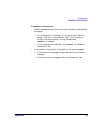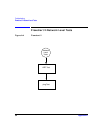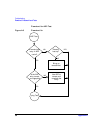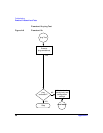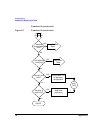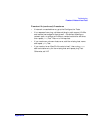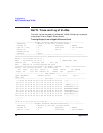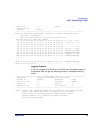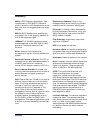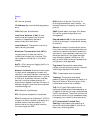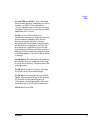
Glossary 75
Glossary
802.1p: IEEE Standard supplement, now
incorporated in IEEE 802.1D. Defines 8
priority levels for traffic classification at the
data link level and suggests how they might
be used.
802.1Q: IEEE Standard that specifies the
architecture for VLAN tagging, association,
and VLAN-capable bridges.
100Base-T: A 100 Mbit/s communication
method specified in the IEEE 802.3u-1995
standard. The official name for Fast
Ethernet.
Alias: Name of the interface that
corresponds to a given Internet address on a
system.
Canonical format indicator: The CFI bit
indicates that all MAC addresses present in
the MAC data field are in canonical
format.HP-UX always transmits a CFI of 0.
Card Instance Number: A number that
uniquely identifies a device within a class. A
class of devices is a logical grouping of
similar devices.
CoS: Class of Service. The ability to provide
different levels of service to various traffic
flows. A flow may be determined explicitly
via tags or implicitly from the frame
contents (such as the IP address or ToS
field). Class of Service (CoS) network
management is when similar types of traffic
(for example, voice, video, or data) are
grouped together and assigned a priority.
Unlike Quality of Service (QoS) traffic
management, CoS does not guarantee a level
of service in terms of bandwidth and delivery
time.
Destination Address: A field in the
message packet format identifying the end
node(s) to which the packet is being sent.
Ethernet: A 10 Mbit/s LAN, developed by
Digital Equipment Corporation, Intel, and
Xerox Corporation, upon which the IEEE
802.3 network is based.
Fast Ethernet: A commonly used name
applied to 100Base-T.
HSC: High speed connect bus.
Hardware Path: An identifier assigned by
the system according to the physical location
(slot) of a card in the hardware backplane.
Hostname: Name of system on the network.
Hub: A network interconnection device that
allows multiple devices to share a single
logical link segment. Hubs are generally
either 10 Mbit/s or 100 Mbit/s devices.
IEEE: The Institute of Electrical and
Electronics Engineers. A national
association, whose activities include
publishing standards applicable to various
electronic technologies. The IEEE technical
committees are numbered and grouped by
area. For example, the 800 committees study
local area network technologies. The 802.3
committee produced the standard for a
CSMA/CD local area network, which has
been adopted by ANSI.
Internet Address: The network address of
a computer node. This address identifies
both which network the host is on and which
host it is. Refer to the Installing and
Administering LAN/9000 Software manual
for detailed information about network
addressing.



